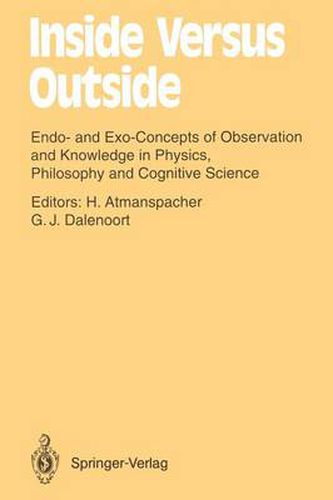Readings Newsletter
Become a Readings Member to make your shopping experience even easier.
Sign in or sign up for free!
You’re not far away from qualifying for FREE standard shipping within Australia
You’ve qualified for FREE standard shipping within Australia
The cart is loading…






This title is printed to order. This book may have been self-published. If so, we cannot guarantee the quality of the content. In the main most books will have gone through the editing process however some may not. We therefore suggest that you be aware of this before ordering this book. If in doubt check either the author or publisher’s details as we are unable to accept any returns unless they are faulty. Please contact us if you have any questions.
In our daily lives we conceive of our surroundings as an objectively given reality. The world is perceived through our senses, and ~hese provide us, so we believe, with a faithful image of the world. But occ~ipnally we are forced to realize that our senses deceive us, e. g. , by illusions. For a while it was believed that the sensation of color is directly r~lated to the frequency of light waves, until E. Land (the inventor of the polaroid camera) showed in detailed experiments that our perception of, say, a colored spot depends on the colors of its surrounding. On the other hand, we may experience hallucinations or dreams as real. Quite evidently, the relationship between the world and our brain is intricate. Another strange problem is the way in which we perceive time or the Now . Psychophysical experiments tell us that the psychological Now is an extended period of time in the sense of physics. The situation was made still more puzzling when, in the nineteen-twenties, Heisenberg and others realized that, by observing processes in the microscopic world of electrons and other elementary particles, we strongly interfere with that world. The outcome of experiments - at least in general - can only be predicted statistically. What is the nature ofthis strange relationship between object and observer ? This is another crucial problem of the inside-outside or endo-exo dichotomy.
$9.00 standard shipping within Australia
FREE standard shipping within Australia for orders over $100.00
Express & International shipping calculated at checkout
Stock availability can be subject to change without notice. We recommend calling the shop or contacting our online team to check availability of low stock items. Please see our Shopping Online page for more details.
This title is printed to order. This book may have been self-published. If so, we cannot guarantee the quality of the content. In the main most books will have gone through the editing process however some may not. We therefore suggest that you be aware of this before ordering this book. If in doubt check either the author or publisher’s details as we are unable to accept any returns unless they are faulty. Please contact us if you have any questions.
In our daily lives we conceive of our surroundings as an objectively given reality. The world is perceived through our senses, and ~hese provide us, so we believe, with a faithful image of the world. But occ~ipnally we are forced to realize that our senses deceive us, e. g. , by illusions. For a while it was believed that the sensation of color is directly r~lated to the frequency of light waves, until E. Land (the inventor of the polaroid camera) showed in detailed experiments that our perception of, say, a colored spot depends on the colors of its surrounding. On the other hand, we may experience hallucinations or dreams as real. Quite evidently, the relationship between the world and our brain is intricate. Another strange problem is the way in which we perceive time or the Now . Psychophysical experiments tell us that the psychological Now is an extended period of time in the sense of physics. The situation was made still more puzzling when, in the nineteen-twenties, Heisenberg and others realized that, by observing processes in the microscopic world of electrons and other elementary particles, we strongly interfere with that world. The outcome of experiments - at least in general - can only be predicted statistically. What is the nature ofthis strange relationship between object and observer ? This is another crucial problem of the inside-outside or endo-exo dichotomy.